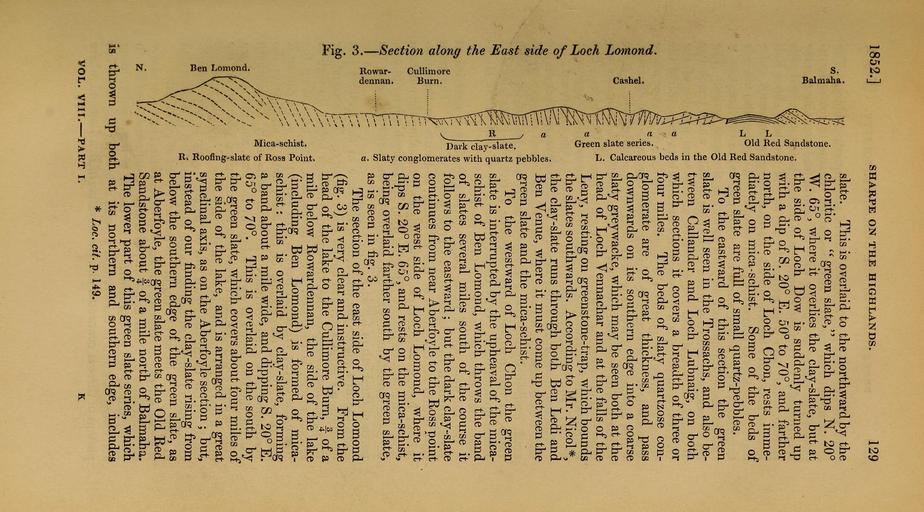MAKE A MEME
View Large Image

| View Original: | The_Quarterly_journal_of_the_Geological_Society_of_London_(12684138465).jpg (3200x1773) | |||
| Download: | Original | Medium | Small | Thumb |
| Courtesy of: | commons.wikimedia.org | More Like This | ||
| Keywords: The Quarterly journal of the Geological Society of London (12684138465).jpg 1852 <br> SHARPE ON THE HIGHLANDS <br> 129 <br> ¢ PS -c <br> is thrown up both <br> VOL YIII PART <br> slate This is overlaid to the northward by the <br> chloritic or green slate which dips N 20° <br> W 65° where it overlies the clay-slate but at <br> the side of Loch Dow is suddenly turned up <br> with a dip of S 20° E 50° to 70° and farther <br> north on the side of Loch Chon rests imme- <br> diately on mica -schist Some of the beds of <br> green slate are full of small quartz-pebbles <br> To the eastward of this section the green <br> slate is well seen in the Trossachs and also be- <br> tween Callander and Loch Lubnaig on both <br> which sections it covers a breadth of three or <br> four miles The beds of slaty quartzose con- <br> glomerate are of great thickness and pass <br> downwards on its southern edge into a coarse <br> slaty greywacke which may be seen both at the <br> head of Loch Vennachar and at the falls of the <br> Leny resting on greenstone-trap which bounds <br> the slates southwards According to Mr Nicol <br> the clay-slate runs through both Ben Ledi and <br> Ben Venue where it must come up between the <br> green slate and the mica-schist <br> To the westward of Loch Chon the green <br> slate is interrupted by the upheaval of the mica- <br> schist of Ben Lomond which throws the band <br> of slates several miles south of the course it <br> follows to the eastward ; but the dark clay-slate <br> continues from near Aberfoyle to the Ross point <br> on the west side of Loch Lomond where it <br> dips S 20° E 65° and rests on the mica-schist <br> being overlaid farther south by the green slate <br> as is seen in fig 3 <br> The section of the east side of Loch Lomond <br> fig 3 is very clear and instructive From the <br> head of the lake to the Cullimore Burn f of a <br> mile below Rowardennan the side of the lake <br> including Ben Lomond is formed of mica- <br> schist this is overlaid by clay-slate forming <br> a band about a mile wide and dipping S 20° E <br> 65° to 70° This is overlaid on the south by <br> the green slate which covers about four miles of <br> the side of the lake and is arranged in a great <br> synclinal axis as on the Aberfoyle section ; but <br> instead of our finding the clay-slate rising from <br> below the southern edge of the green slate as <br> at Aberfoyle the green slate meets the Old Red <br> Sandstone about f of a mile north of Balmaha <br> The lower part of this green slate series which <br> at its northern and southern edge includes <br> Loc cit p 149 <br> I K 35461131 109911 51125 Page 129 Text v 8 http //www biodiversitylibrary org/page/35461131 1852 Geological Society of London Biodiversity Heritage Library The Quarterly journal of the Geological Society of London v 8 1852 Geology Periodicals Smithsonian Libraries bhl page 35461131 dc identifier http //biodiversitylibrary org/page/35461131 smithsonian libraries Information field Flickr posted date ISOdate 2014-02-21 Check categories 2015 August 26 CC-BY-2 0 BioDivLibrary https //flickr com/photos/61021753 N02/12684138465 2015-08-27 11 54 30 cc-by-2 0 PD-old-70-1923 The Quarterly journal of the Geological Society of London 1852 Photos uploaded from Flickr by Fæ using a script | ||||